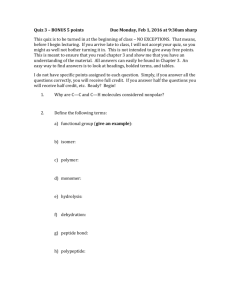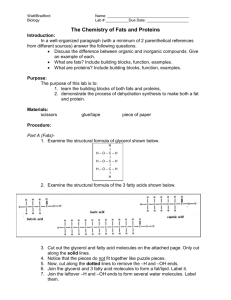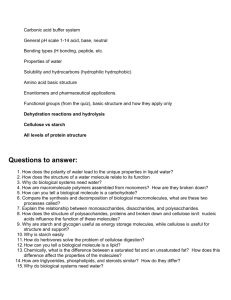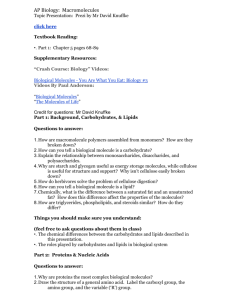Chapter 4/5 Worksheet
advertisement
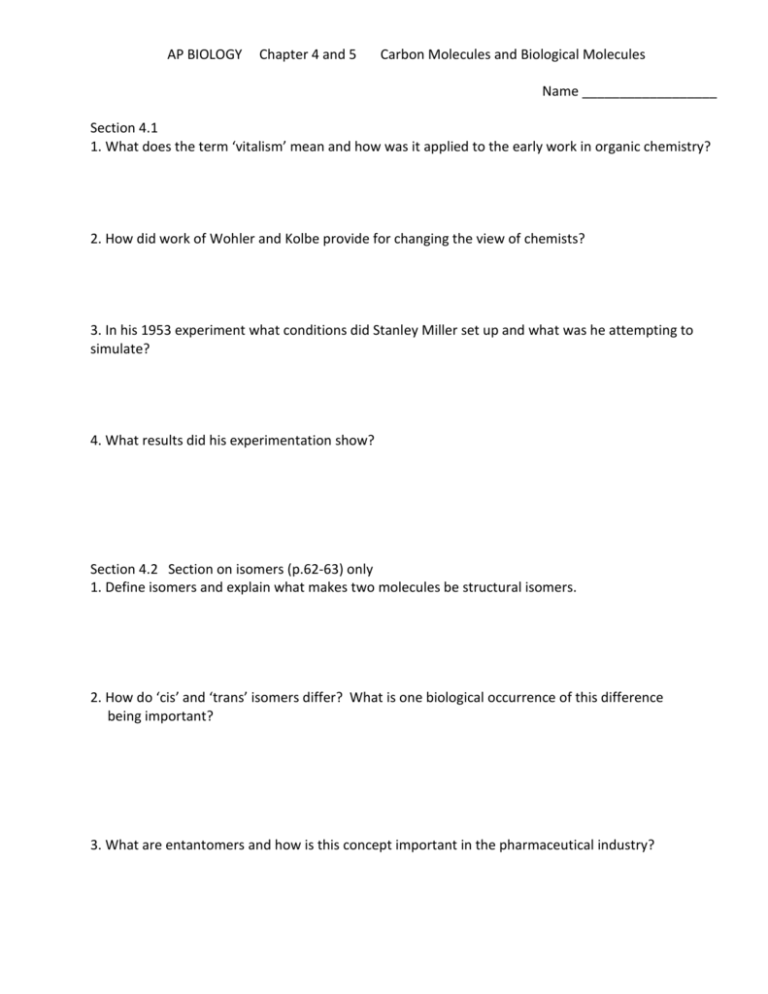
AP BIOLOGY Chapter 4 and 5 Carbon Molecules and Biological Molecules Name __________________ Section 4.1 1. What does the term ‘vitalism’ mean and how was it applied to the early work in organic chemistry? 2. How did work of Wohler and Kolbe provide for changing the view of chemists? 3. In his 1953 experiment what conditions did Stanley Miller set up and what was he attempting to simulate? 4. What results did his experimentation show? Section 4.2 Section on isomers (p.62-63) only 1. Define isomers and explain what makes two molecules be structural isomers. 2. How do ‘cis’ and ‘trans’ isomers differ? What is one biological occurrence of this difference being important? 3. What are entantomers and how is this concept important in the pharmaceutical industry? Section 4.3 1. What is the importance of functional groups on organic molecules? 2. Sketch structures of the following functional groups: amino, carbonyl (both types – ketone and aldehyde), carboxyl, hydroxyl, phosphate, methyl, and sulfhydryl. In text look at examples and read about properties of these (but no need to memorize these details). Chapter 5 Overview and Section 5.1 1. Define and describe relationship in biochemical molecules between monomers, macromolecules, and polymers. 2. Describe relationship between dehydration reaction (synthesis) and hydrolysis. Show, in a diagram, general features of dehydration synthesis and hydrolysis reactions. 3. Look throughout this chapter (and/or in other sources--- physio notes!) and list the element types present in each of the biochemical molecule groups: Carbohydrates – Proteins – Lipids – Nucleic Acids – Section 5.2 1. Complete the following chart for simple sugars (monosaccharides): C – Numbers Group Name Molecular Formula 3 Types in Group 1. 2. 5 1. 2. 6 1. 2. 3. 2. Show in ‘word equations’ the reactions in which monosaccharides combine to form the three disaccharides. 3. Show alpha and beta forms of glucose dissolved in water. 4. Complete the following chart for polysaccharides: Category Type(s) Name POLYSACCHARIDES Animal or Plant Linkage 1. Starches 2. 3. Structural 1. 2. Section 5.3 1. Describe structure of a fatty acid. Why are they generally hydrophobic? 2. How do saturated and unsaturated fatty acids differ structurally? 3. Compare fats and oils. Include structure, physical properties, occurrence, and human health aspects. 4. Discuss presence and health concerns of cis and trans bond arrangement in fatty acids and foods. 5. Discuss adaptiveness of specific molecule types in the following situations: a. fats in animals for energy storage b. starches in plants for energy storage, but oils in seeds 6. Compare structures of phospholipids and triglycerides. How are phospholipids utilized in cells? Section 5.4 1. State 8 functions of specific proteins. a. b. c. d. e. f. g. h. 2. Show general structure of an amino acid and how two amino acids combine by a peptide bond. 3. Differentiate between the terms polypeptide and protein. 4. What is primary structure of a protein and how does it permit a tremendous variety of proteins? 5. Describe alpha helix and beta-pleated sheet secondary structures of proteins. 6. Tertiary structure results from interactions between amino acid _____________ ___________. Give names and describe briefly the FOUR types of interactions (a 5th will be added in class) Interaction Describe Briefly 1. 2. 3. 4. 5. 7. Quaternary structure is due to what? Name two common proteins and explain how they show this structural level. 8. Describe one example in which a change of an amino acid in a protein can alter the resulting protein’s functioning. Section 5.5 1. Give the full name for – DNA RNA – 2. The monomer unit of nucleic acids is a __________________________. 3. What are the three subparts contained within this monomer unit? 4. Complete this chart of nitrogenous bases: Category #Rings Types In RNA? 1. Pyrimidine 2. 3. Purine 1. 2. (No need to read remaining parts of this section after answering the last question) In DNA?


